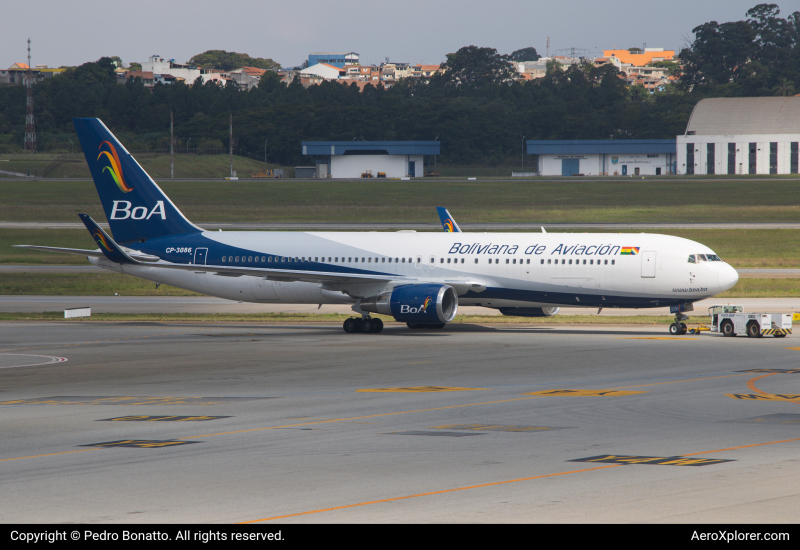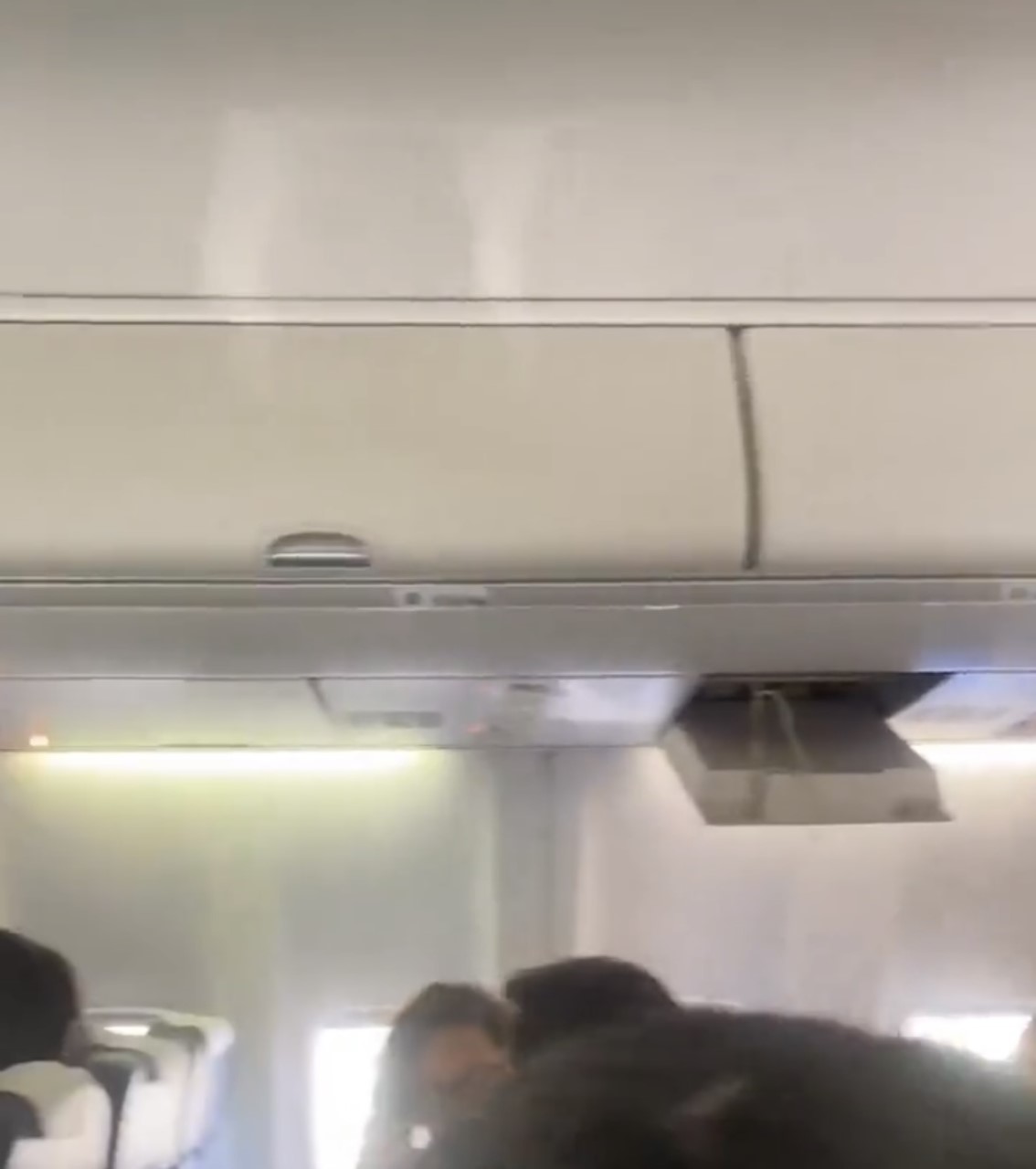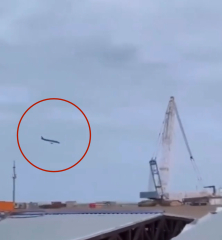The wing and interior cabin of a Boeing 737-800 have been damaged upon the aircraft's landing at Sao Paulo Guarulhos Int'l (GRU) in Brazil.

Boliviana De Aviacion Flight 736
On the morning of May 4th, a Boliviana de Aviacion Boeing 737-800, registration CP-3151 took off from Santa Cruz Viru Viru Int'l (VVI) Airport's runway 16 bound for Sao Paulo Guarulhos Int'l (GRU). After an uneventful two hours and 20 minutes in the air, the flight came in for a landing at GRU airport's runway 09R. It was upon the aircraft landing at the airport that the flight became scary for the passengers onboard.
A plane-spotting live stream caught the fateful landing of flight 736 in Sao Paulo. At first, all looks normal, with the Boeing 737-800 touching down and creating the usual plume of smoke (due to the normal rapid tire acceleration). Mere seconds after this, part of the wing-tip of the aircraft can be seen flying off the wing in real-time.

Besides the wing-tip breaking off, various interior panels also appear to have been damaged during the landing as shown in a video posted to social media following the incident by one of the passengers onboard the aircraft.


Many on social media who have seen the video have pointed out that the aircraft didn't make a particularly hard or damaging landing. The rather normal touch-down (if not for landing a third of the way down the runway) most likely indicates a fault of some sort with CP-3151, the Boeing 737-800 aircraft involved in the incident.

Of the menagerie of parts on the Boeing 737-800, the most likely culprit is either a locked-up brake on one of the three landing gears of the aircraft, or faulty landing gear dampers. The first of the latter, locked-up landing gear brakes, seems the least likely due to the fact that if there truly was an issue with the brakes, then there would be a more than usual amount of smoke visible during the landing and possibly sparks or a fire on the landing gear with the locked brake. This leaves the landing gear dampers as one of the most likely culprits for the damage done to the aircraft.
The Boeing 737-800 has two main landing gear dampers on each of its landing gear wheels. The first is a rather small, secondary damper located between the -800's two large wheels on each of its landing gears (forward, back left, and back right). This is called the shimmy damper and plays a rather minimal role in allowing for smoother landings and absorbing oscillations.
The second and largest type of landing gear damper featured on the 737-800 is called the shock strut. If a landing gear shock strut, or any aircraft part for that matter, hasn't been maintained properly, then it will be more easily prone to failure.
The importance of landing gear dampers during landing and takeoff is pretty rudimentary - to absorb excess vibrations and shocks so that the aircraft isn't damaged during the crucial moments of takeoff and landing. A possible fault in one, or multiple of the landing gear dampers would cause excess vibrations and oscillations throughout the cabin, leading to the various panels seen in the video and photos falling out as they did. As for the winglet flying off the aircraft, these same oscillations could have caused the winglet to break off.
These are only speculations. Only the actual investigation, if any is conducted, into the accident will reveal why the Boeing 737-800 aircraft was damaged in such a violent way after a rather average landing.
As of Friday, May 5th, Boliviana de Aviacion has not released a statement in regard to the incident.
Ethiopian Airlines Expands Fleet with Second Airbus A350-1000 » PHOTOS: Azerbaijan Airlines E190 Crashes in Kazakhstan » South African Airways Eyes India–South Africa Route »
Comments (0)
Add Your Comment
SHARE
TAGS
NEWS BOA Boliviana de Aviacion Boeing 737-800 Sao Paulo GRU VVI Incident Brazil BoliviaRECENTLY PUBLISHED
 PHOTOS: Azerbaijan Airlines E190 Crashes in Kazakhstan
An Azerbaijan Airlines Embraer E190 crashed approximately 3 km from the city of Aktau today, December 25. Images from the scene show that the aircraft lost speed and then crashed, followed by a large explosion.
NEWS
READ MORE »
PHOTOS: Azerbaijan Airlines E190 Crashes in Kazakhstan
An Azerbaijan Airlines Embraer E190 crashed approximately 3 km from the city of Aktau today, December 25. Images from the scene show that the aircraft lost speed and then crashed, followed by a large explosion.
NEWS
READ MORE »
 South African Airways Eyes India–South Africa Route
As part of its recovery strategy, South African Airways (SAA) is exploring the reinstatement of direct flights between India and South Africa. SAA, along with Minister of Tourism Patricia de Lille, on December 3, 2024, participated in a high-level delegation to India to strengthen aviation and tourism ties between the two nations.
ROUTES
READ MORE »
South African Airways Eyes India–South Africa Route
As part of its recovery strategy, South African Airways (SAA) is exploring the reinstatement of direct flights between India and South Africa. SAA, along with Minister of Tourism Patricia de Lille, on December 3, 2024, participated in a high-level delegation to India to strengthen aviation and tourism ties between the two nations.
ROUTES
READ MORE »
 Ethiopian Airlines Expands Fleet with Second Airbus A350-1000
Ethiopian Airlines, Ethiopia's national carrier, has taken delivery of its second Airbus A350-1000, registered as ET-BAX. This advanced aircraft is powered by Trent XWB-97 engines, further solidifying the airline’s commitment to modernizing its fleet.
NEWS
READ MORE »
Ethiopian Airlines Expands Fleet with Second Airbus A350-1000
Ethiopian Airlines, Ethiopia's national carrier, has taken delivery of its second Airbus A350-1000, registered as ET-BAX. This advanced aircraft is powered by Trent XWB-97 engines, further solidifying the airline’s commitment to modernizing its fleet.
NEWS
READ MORE »





